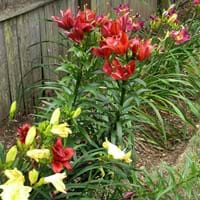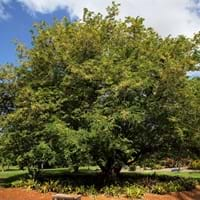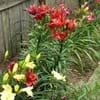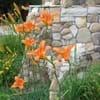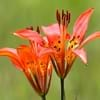Life Span
Perennial
Perennial
Type
Bulb or Corm or Tuber
Tree
Origin
Hybrid origin, North America, Europe, Africa, Asia
Africa, India, Southeast Asia
Types
White lily, orange lily, Lily of the valley
Sweet Tamarind, Australian tamarind, Manila tamarind, Velvet tamarind, Spanish Tamarind
Habitat
Not Available
Subtropical climates, Tropical regions
USDA Hardiness Zone
2-8
9-11
AHS Heat Zone
8-1
Not Available
Sunset Zone
21,22
Not Available
Habit
Upright/Erect
Spreading
Flower Color
White, Yellow, Red, Green, Purple, Gold, Pink, Rose, Peach, Burgundy, Bronze
Red, Yellow
Flower Color Modifier
Bicolor
Bicolor
Fruit Color
Yellow green, Sandy Brown
Brown
Leaf Color in Spring
Green, Dark Green
Green
Leaf Color in Summer
Light Green
Dark Green, Green
Leaf Color in Fall
Several shades of Green
Dark Green, Yellow green
Leaf Color in Winter
Light Green
Dark Brown, Green
Leaf Shape
Long Linear
Pinnate
Plant Season
Spring, Summer, Fall
Spring, Summer, Fall, Winter
Sunlight
Full Sun, Partial Sun, Partial shade
Full Sun, Partial Sun
Type of Soil
Clay, Loam, Sand
Clay, Loam, Sand
The pH of Soil
Acidic, Neutral, Alkaline
Acidic
Soil Drainage
Well drained
Average
Bloom Time
Not Available
Late Spring
Tolerances
Drought
Drought, Salt
Where to Plant?
Container, Ground, Pot
Ground
How to Plant?
Seedlings
Layering, Seedlings, Transplanting
Plant Maintenance
Medium
Low
Watering Requirements
Do Not over Water
Do Not over Water, Keep the ground moist but not water-logged
In Summer
Lots of watering
Lots of watering
In Spring
Moderate
Moderate
In Winter
Average Water
Average Water
Soil pH
Acidic, Neutral, Alkaline
Acidic
Soil Type
Clay, Loam, Sand
Clay, Loam, Sand
Soil Drainage Capacity
Well drained
Average
Sun Exposure
Full Sun, Partial Sun, Partial shade
Full Sun, Partial Sun
Pruning
Prune in early spring, Prune in fall, Remove dead or diseased plant parts
Remove damaged leaves, Remove dead branches, Remove dead leaves
Fertilizers
All-Purpose Liquid Fertilizer, Fertilize only when soil is poor
6-6-6 or 8-8-8
Pests and Diseases
Lily Beetle
Aphids, Borers, Mealybugs, Onion thrips, Root weevil, Soft scales, Whiteflies
Plant Tolerance
Drought
Drought
Flower Petal Number
Single
Single
Foliage Texture
Not Available
Bold
Foliage Sheen
Not Available
Matte
Attracts
Not Available
Beetles, Birds, Scale Insects
Allergy
Not Available
Diarrhea, Hives, Nausea, Vomiting
Aesthetic Uses
Beautification, Showy Purposes
Beautification
Beauty Benefits
Making cosmetics
Glowing Skin, Good for skin, Improve skin tone, Reduces ageing, Skin cleanser
Environmental Uses
Not Available
Food for animals, Food for birds, Food for insects, Nesting sites for birds
Medicinal Uses
Burns, Diuretic, Heart problems
Antioxidants, Inflammation, Rheumatism, Skin Disorders, Sore throat
Part of Plant Used
Whole plant
Flowers, Fruits, Leaves
Other Uses
Cosmetics, Oil is used for aromatherapy, Used As Food, Used as Ornamental plant, Used for its medicinal properties
Culinary use, Used as a nutritious food item, Used as Ornamental plant, Used for its medicinal properties
Used As Indoor Plant
Yes
No
Used As Outdoor Plant
Yes
Yes
Garden Design
Alpine, Container, Cutflower, Feature Plant, Mixed Border, Wildflower
Edible, Fruit / Fruit Tree, Shade Trees
Botanical Name
LILIUM
Tamarindus indica
Common Name
Lily
Tamarind tree, Tamarind
In Hindi
लिली
इमली का पेड़
In German
Lilie
Tamarinde
In Spanish
Lirio
tamarindo
In Greek
Κρίνος
δέντρο Tamarind
In Portuguese
Lírio
tamarindo
In Polish
Lilia
drzewo tamaryndowca
In Latin
lilium
tamarind ligno
Phylum
Tracheobionta
Magnoliophyta
Class
Liliopsida
Magnoliopsida
Family
Liliaceae
Fabaceae
Clade
Angiosperms, Monocots
Angiosperms, Eudicots, Rosids
Subfamily
Lilioideae
Caesalpinioideae
Number of Species
Not Available
Season and Care of Lily and Tamarind tree
Season and care of Lily and Tamarind tree is important to know. While considering everything about Lily and Tamarind tree Care, growing season is an essential factor. Lily season is Spring, Summer and Fall and Tamarind tree season is Spring, Summer and Fall. The type of soil for Lily is Clay, Loam, Sand and for Tamarind tree is Clay, Loam, Sand while the PH of soil for Lily is Acidic, Neutral, Alkaline and for Tamarind tree is Acidic.
Lily and Tamarind tree Physical Information
Lily and Tamarind tree physical information is very important for comparison. Lily height is 30.00 cm and width 30.00 cm whereas Tamarind tree height is 1,800.00 cm and width 800.00 cm. The color specification of Lily and Tamarind tree are as follows:
Lily flower color: White, Yellow, Red, Green, Purple, Gold, Pink, Rose, Peach, Burgundy and Bronze
Lily leaf color: Green and Dark Green
Tamarind tree flower color: Red and Yellow
- Tamarind tree leaf color: Green
Care of Lily and Tamarind tree
Care of Lily and Tamarind tree include pruning, fertilizers, watering etc. Lily pruning is done Prune in early spring, Prune in fall and Remove dead or diseased plant parts and Tamarind tree pruning is done Remove damaged leaves, Remove dead branches and Remove dead leaves. In summer Lily needs Lots of watering and in winter, it needs Average Water. Whereas, in summer Tamarind tree needs Lots of watering and in winter, it needs Average Water.
